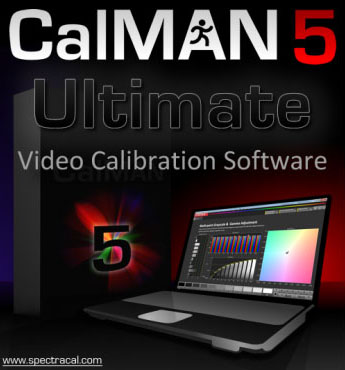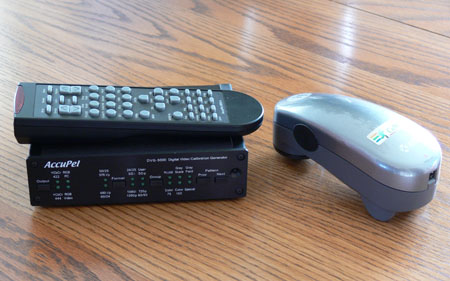VP2770-LED Vs. S27B970D: 27" Monitors At 2560x1440
If you demand maximum pixel density and the highest resolution on your desktop PC, these 27-inch screens from ViewSonic and Samsung do not disappoint. Today, we put ViewSonic's VP2770-LED and Samsung's S27B970D to the test. Is QHD right for you?
Test Setup And The S27B970D's Unique Features
To measure and calibrate monitors, we use an i1Pro spectrophotometer and the latest version of SpectraCal CalMAN software (v5.0.3).
For patterns, we employ an AccuPel DVG-5000 video signal generator. This approach removes video cards and drivers from the signal chain, allowing the display to receive true reference patterns. Connections are made via HDMI.
The AccuPel DVG-5000 is capable of generating all types of video signals at any resolution and refresh rate up to 1920x1080 at 60 Hz. It can also display motion patterns to evaluate a monitor's video processing capabilities, with 3D patterns available in every format. This allows us to measure color and grayscale performance, crosstalk, and ghosting in 3D content via the 3D glasses.
Samsung S27B970D Extras
Before moving on to the benchmarks, we need to talk about some of the unique features of Samsung's S27B970D. This monitor offers five picture modes, all of which have unique properties that affect the test results. The Calibrated mode refers to a factory-adjusted preset that locks out all adjustments, including brightness and contrast. The only way to alter it is to use the Natural Color Expert software with one of four supported color probes. Yes, the i1Pro is one of these. The only mode that allows full access to the controls is Standard, and this is the mode we used in our testing. Even with the NCE software, we weren’t able to achieve better results than we did with a manual calibration in Standard mode.
The table below contains the settings we used to generate our results, so feel free to try them out. They are likely to improve your monitor’s image, although slight variations between samples do exist and no two monitors calibrate exactly the same. A color probe and the appropriate software will always give you the best results.
| ViewSonic VP2770-LED | |
|---|---|
| Mode | User Color |
| Contrast | 70 |
| Brightness | 42 |
| RGB | 98/100/94 |
| Sharpness | 0 |
| Gamma | Standard |
| Samsung S27B970D | |
| Mode | Standard |
| Contrast | 75 |
| Brightness | 84 |
| RGB | 53/46/50 |
| Sharpness | 60 |
| Gamma | 2.2 |
Note that any Sharpness setting above 0 on the ViewSonic causes visible ringing, also known as edge enhancement. This appears as white outlines around black text and other dark objects when they are rendered on a light-colored background.
Get Tom's Hardware's best news and in-depth reviews, straight to your inbox.
Current page: Test Setup And The S27B970D's Unique Features
Prev Page ViewSonic VP2770-LED And Samsung S27B970D Next Page Results: Stock Brightness And Contrast
Christian Eberle is a Contributing Editor for Tom's Hardware US. He's a veteran reviewer of A/V equipment, specializing in monitors. Christian began his obsession with tech when he built his first PC in 1991, a 286 running DOS 3.0 at a blazing 12MHz. In 2006, he undertook training from the Imaging Science Foundation in video calibration and testing and thus started a passion for precise imaging that persists to this day. He is also a professional musician with a degree from the New England Conservatory as a classical bassoonist which he used to good effect as a performer with the West Point Army Band from 1987 to 2013. He enjoys watching movies and listening to high-end audio in his custom-built home theater and can be seen riding trails near his home on a race-ready ICE VTX recumbent trike. Christian enjoys the endless summer in Florida where he lives with his wife and Chihuahua and plays with orchestras around the state.
-
mayankleoboy1 ReplyWhy wouldn't you want a QHD screen like one of these two?
Everything gets smaller.
So increase the DPI scaling ?
-
MauveCloud BigMack70I'm glad to see 1440p monitors getting some attention, but I just don't see the prices of these being justifiable to most users over the USA-based Korean 1440p IPS panels that are starting to become more numerous.$800-1200 is just nuts for anyone using these for home use or gaming, IMO.Reply
Agreed. I bought a Dell U2711 a few months ago, but if something forced me to replace it, I'd probably go with one of those cheap Korean panels -- or a TN panel 2560x1440 monitor if somebody would actually make one - I doubt I'm the only one who likes the resolution but isn't so picky about color quality. I had no objection to the color quality on my Samsung P2770HD, and the color shifts of a TN panel are affected by the physical size of the monitor, not the resolution, right? -
Why not do a review on those $330 Korean 1440P monitors that enthusiasts talk about? I like to see what i am missing with the extra $900. Really i'm serious i really want to know what justifies the 1 grand price tag.Reply
-
cangelini jupiter optimus maximusWhy not do a review on those $330 Korean 1440P monitors that enthusiasts talk about? I like to see what i am missing with the extra $900. Really i'm serious i really want to know what justifies the 1 grand price tag.It's coming. We're ramping up our display coverage, so we took note of the requests after the last display piece and put in the requests. You'll see this soon. Of course, if there are any other requests from you guys, do let us know. Christian is doing a phenomenal job of applying his extensive experience on Tom's Hardware.Reply -
EzioAs Dell's UltraSharp U2713HM is less than $600 in my country if we go by standard conversion. Would you guys say that's a good price?Reply -
festerovic cangeliniIt's coming. We're ramping up our display coverage, so we took note of the requests after the last display piece and put in the requests. You'll see this soon. Of course, if there are any other requests from you guys, do let us know. Christian is doing a phenomenal job of applying his extensive experience on Tom's Hardware.That's great to hear, I agree with the others that the price of these models is too much to consider unless they were generating $$$s for me. $3-400 seems like the range I would be willing to spend on these. And as for the USA based korean cheap models, are there any legit retailers of these? Please point me at them.Reply -
JOSHSKORN Just bought a ASUS VS278Q-P for $310. It's a 60Mz monitor and I do game, but I'm happy. My previous monitor lasted 8 years (Samsung SyncMaster 213T, bought it for $1k). I'll upgrade when this one dies, hopefully 4k/UHD will be affordable. Supposedly, only serious gamers can tell the difference between 60Hz and 120Hz. I'm not a serious gamer, so it works just fine for me. 120Hz monitors of that size are nearly twice the price.Reply -
mannam Reply10449443 said:It's coming. We're ramping up our display coverage, so we took note of the requests after the last display piece and put in the requests. You'll see this soon. Of course, if there are any other requests from you guys, do let us know. Christian is doing a phenomenal job of applying his extensive experience on Tom's Hardware.
Here are the inexpensive $300-$400 27" korean monitor brands: Yamakasi Catleap, Achieva Shimian, Crossover, PCBank, Potalion, Auria
"The reason these monitors are cheap - LG makes IPS panels for apple cinema displays. Apple only accepts grade A+ panels. That means the all the grade A,A-,B+, etc are not accepted and returned to LG. LG resells those IPS panels to other manufacturers. You can get the whole story on google if you're interested. In addition, you're getting no support and no manufacturers warranty."
Source: http://www.mmorpg.com/gamelist.cfm?game=239&view=forums&post=5192222#5192222
It would be really interesting to get a review of these monitors that go for 50% or less of the price of the Big Brand stuff. If it's even 85-90% quality compared to the big brands, then they are worth the plunge. :D -
ubercake Personally, I was not impressed with the Auria monitor. My Acer HN274H TN monitor has better contrast. Viewing angles are far better on the Auria, but that's to be expected on an IPS. At any rate, I returned the Auria after a day of use because after many attempts to adjust the contrast/color, it didn't hold a candle to the colors or contrast on my TN. The Auria definitely had deeper black, but the in-betweens seemed to be missing no matter how I set the contrast and color. I honestly couldn't justify the tradeoff of higher resolution to lack of contrast. Maybe I got one of the LG B+ throw-away panels?Reply

